You’ve heard so many people say food is medicine right?
So if food really is medicine, then it should kill pain, shouldn’t it?
Well certain foods actually can!
You might be wondering why anyone would choose to head to the fridge when they’re in pain instead of reaching for some painkillers.
Well, side effects of these drugs include nausea, vomiting, stomach ache, dizziness, worsening of asthma symptoms, fluid retention, stomach ulcers and more.
And, given that narcotic painkillers allegedly kill more people than murders and fatal car accidents in the US, perhaps eating for pain relief is the wisest option!
Here are some of the best soothing foods, chosen for their ability to kill pain and reduce inflammation in the body.
Herbs
 Herbs do much more than just flavor your food. They can also help deal with a variety of aches and pains you might have.
Herbs do much more than just flavor your food. They can also help deal with a variety of aches and pains you might have.
While most herbs have some anti-inflammatory and other pain relieving properties, in particular you should try:
- Basil – in studies, a basil extract has been shown to reduce swelling in arthritis sufferers by up to 73%, in just 24 hours!
- Oregano – this healing herb has more antioxidants than most fruit. Research has shown a little goes a long way, a half teaspoon daily is all that’s needed to quash inflammatory activity.
- Thyme – researchers have found that thyme is an excellent pain-relieving herb. Amazingly, it has been shown to work better than ibruprofen, particularly for menstrual pain.
Spices
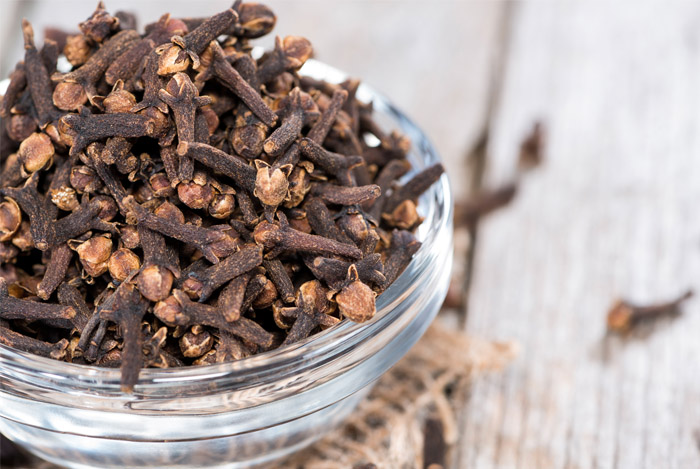 Just like herbs, spices are an incredible secret weapon when it comes to pain relief. Add spices to your meals, from your morning smoothie to your snacks, and you’ll feel the pain melt away.
Just like herbs, spices are an incredible secret weapon when it comes to pain relief. Add spices to your meals, from your morning smoothie to your snacks, and you’ll feel the pain melt away.
Spices that are especially noted for their ability to kill pain include:
- Cayenne or chili pepper – a compound in these spices, known as capsaicin, reduces the amount of substance P, a chemical that carries pain messages to the brain. A study of one man who was injured due to a bomb explosion, reported his pain levels dropped by 80% when using a high concentration topically applied capsaicin patch!
- Cloves – eugenol is the name of the substance in cloves that gives them their analgesic and antibacterial properties. When comparing the numbing effect of clove gel and benzocaine on sore gums, both worked equally well.
- Turmeric – one of the most anti-inflammatory spices around, turmeric contains the important compound, curcumin. Shortly after receiving curcumin, rats suffering neuropathic pain were thought to exhibit a decline in pain behaviors.
- Black pepper – this common seasoning contains piperine, a chemical that counteracts pain in the body. Take black pepper along with turmeric as the piperine can increase curcumin bioavailability by 2000%!
- Ginger – from the same family as turmeric, ginger offers all the same pain-relieving benefits. Check out my post on this potent spice for the full lowdown.
- Cinnamon – along with anti-inflammatory and antioxidant powers, the chemical cinnamaldehyde found in cinnamon is a powerful anti-fungal, making it a great cure for candida, athlete’s foot, or toenail fungus.
Cherries
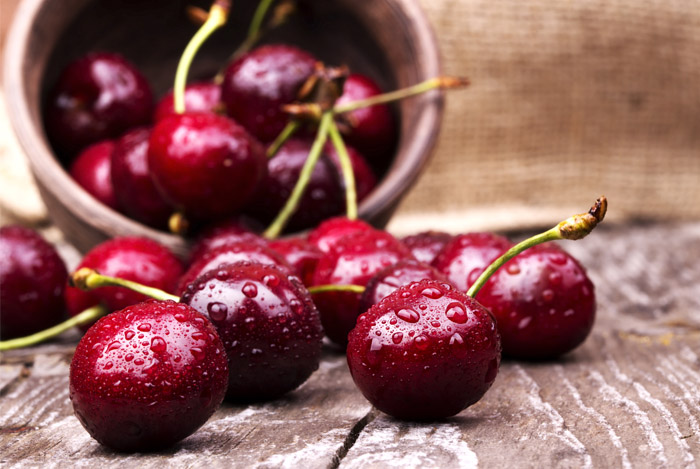 Not only do cherries taste better than junk food, but they have been shown to kill pain too.
Not only do cherries taste better than junk food, but they have been shown to kill pain too.
How many should you eat to see a difference?
According to a US Department of Agriculture study, 280 g of cherries, around two cups with pits, is what you should eat to obtain the highest pain relieving benefits.
Participants in the study ate the cherries for 28 days. Afterwards, their blood tests showed lower levels of common markers of inflammation.
Another study of 633 individuals with gout (an inflammatory condition) were given cherries over a two day period. Afterwards, participants saw a 35% lower risk of gout attacks, compared to those who didn’t consume cherries.
If you don’t fancy facing two cups of cherries every day, why not try the juice?
Runners who drank 12 ounces of tart cherry juice twice daily for one week before, and during, a strenuous running event experienced less muscle soreness than other athletes.
Tart, dark cherries are also one of the best foods to help you fall asleep.
Fish & Fish Oil
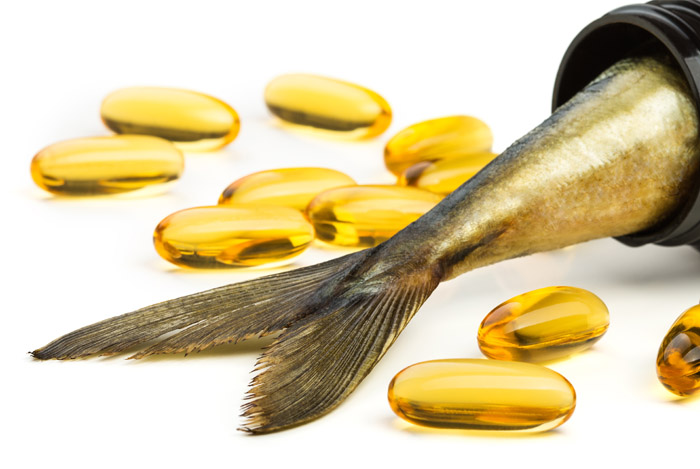 As I’ve said before, fish is one of the healthiest foods in the world.
As I’ve said before, fish is one of the healthiest foods in the world.
It’s one of the best sources of omega 3 fatty acids, which are potent anti-inflammatories. They also lower blood pressure and reduce the risk of stroke and heart failure.
So powerful are these fats in reducing pain, that several studies like this one, have shown omega 3s from fish oil to be just as effective as ibuprofen at killing pain, particularly the pain linked to arthritis.
After just 3 months of supplementation, 59% of participants in the study stopped taking their prescribed pain medications thanks to the power of the fish oil.
According to Web MD, you should be aiming to take 2 to 4 grams of the omgea 3 acids DHA and EPA daily for relief from chronic pain.
If you’re a vegan or vegetarian, you can get omega 3s from walnuts, flaxseeds, and fortified cereals.
Probiotics
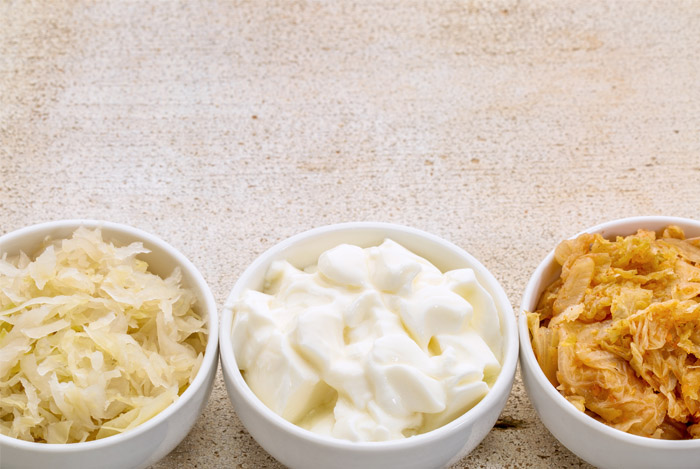 Several strains of probiotic bacteria can reduce pain, inflammation and bloating.
Several strains of probiotic bacteria can reduce pain, inflammation and bloating.
A study that looked at the effects of probiotic bacteria on patients with chronic fatigue syndrome, psoriasis, and ulcerative colitis (conditions caused by inflammation) found that after taking beneficial bacteria, participants showed reduced levels of inflammation in the body.
Eating natural yogurt, which contains probiotic bacteria, was also shown to reduce inflammation in those with type 2 diabetes, as well as those with inflammatory bowel disease.
You can take probiotic supplements or try probiotic rich foods such as yogurt (always check the label for ‘live bacteria’), kefir, kombucha, or sauerkraut.
Coffee
 Coffee is chock full of antioxidants, which means it can help prevent conditions like Alzheimer’s, diabetes, and cancer.
Coffee is chock full of antioxidants, which means it can help prevent conditions like Alzheimer’s, diabetes, and cancer.
These antioxidants can also fight inflammation, with coffee being especially potent in killing the pain associated with headaches and exercise induced muscle pain.
Research carried out at the University of Georgia showed that moderate doses of caffeine, about two cups of coffee, can reduce post-workout pain by 48%.
Caffeine can also get rid of a thumping headache or migraine, thanks to its ‘vasoconstrictive’ properties. These cause the blood vessels to narrow and restrict blood flow, leading to pain relief.
Here’s the caveat: caffeine will generally only help headache pain if you don’t drink it too often. Too much coffee can also cause headaches, as they are a common symptom of caffeine withdrawal!
If you’re taking pain relieving medication like paracetamol, ibuprofen or aspirin, then caffeine can enhance their analgesic abilities, by around 40%. That’s why you often find caffeine as an ingredient in migraine medication or other painkillers.
A study has found that a 100 mg to 130 mg caffeine supplement (equal to about one cup of coffee) will enhance pain relief when taken with a standard dose of pain reliever.
Olive Oil
 It’s long been known that a Mediterranean style diet is one of the best diets you can follow for optimal health.
It’s long been known that a Mediterranean style diet is one of the best diets you can follow for optimal health.
One reason for this is because the diet is full of anti-inflammatory foods, including olive oil.
Research has found that extra virgin olive oil contains a compound, oleocanthal, which mimics the effects of ibuprofen.
A 50 gram (1.75 oz) daily dose of olive oil has about 10% of the pain relieving power of a standard adult dose of ibuprofen.
While the dose is relatively low, researchers say low doses of other anti-inflammatory agents, like aspirin, can provide substantial health benefits when taken consistently over time.
Plus, olive oil is a healthy fat and is much better for you than many other cooking oils, so it can’t hurt to add it to your diet.
Dr. Weil, creator of the anti-inflammatory diet, says you can tell if your olive oil contains this pain killing compound through a simple taste test. If the oil tastes peppery and stings your throat when swallowing, it’s a keeper.
Red Grapes
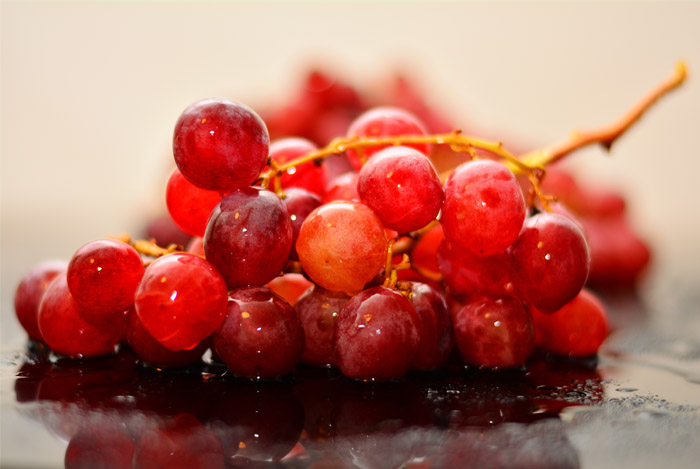 Just like cherries, red grapes are another fruit that pack a painkilling punch.
Just like cherries, red grapes are another fruit that pack a painkilling punch.
They have been shown to help dissolve uric acid crystals, which can reduce rheumatoid arthritis symptoms, prevent painful gout attacks and stop the formation of kidney stones.
What’s more, the skin of red grapes contain resveratrol, a chemical compound that exhibits strong anti-inflammatory activities.
Human studies have shown that resveratrol blocks free radical activity, which is responsible for cancer, aging and the release of pro-inflammatory substances into the blood, suggesting that it could ultimately help fight pain.
Other food sources of resveratrol include red wine, peanuts, blueberries, and cranberries.
Green Tea
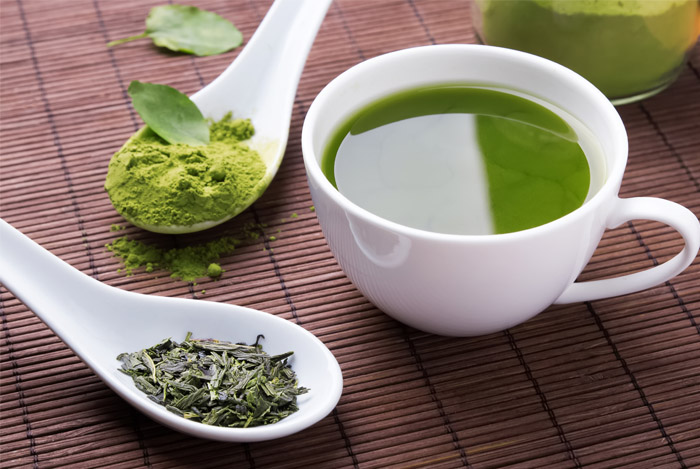 It’s no secret that green tea is an amazing tonic and comforting drink all in one.
It’s no secret that green tea is an amazing tonic and comforting drink all in one.
For one thing, it’s full of antioxidants, which we know can fight the free radicals that lead to inflammation.
In lab studies, researchers in Cleveland showed that EGCG, a substance in green tea, may halt arthritis progression by blocking interleukin-1, a pro-inflammatory cell, from damaging cartilage.
If you suffer from sore gums or mouth ulcers, you’ll be happy to hear that green tea has been shown to help prevent dental cavities and gum disease, thanks to its anti-bacterial qualities.
This amazing tea also helps maintain an overall healthy heart, leading to a longer lifespan. It is also known to protect the brain and immune system, and contribute to weight loss.
According to a review of studies, the usual recommendation for full health benefits is around three or four cups a day.
Garlic
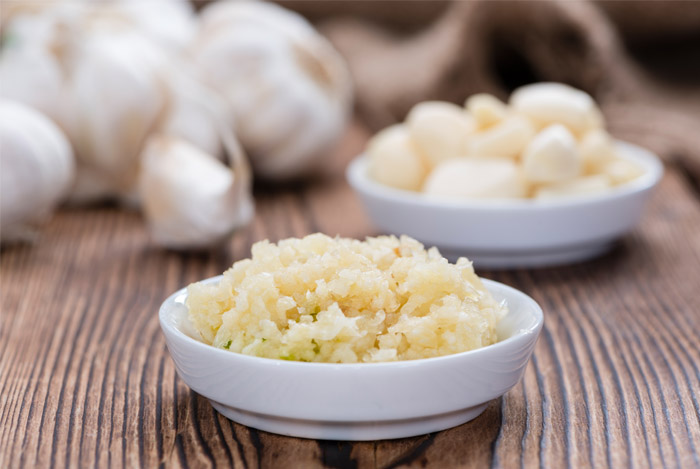 While technically an herb, garlic is such a superfood, I thought it deserved a stand-alone mention.
While technically an herb, garlic is such a superfood, I thought it deserved a stand-alone mention.
This ‘stinking rose’ (as it’s known) has been used since ancient times as a natural medicine thanks to its antibacterial, antiviral, anti-fungal, and anti-inflammatory properties.
In fact, garlic contains chemicals that shut down inflammatory pathways in the same way that ibuprofen, and other painkillers do.
A 1999 study found that a garlic preparation taken twice daily for up to six weeks was just as effective as conventional treatments for rheumatoid arthritis.
Garlic is also thought to help fight cancer, promote a healthy heart, lower blood pressure, and protect the brain.
The secret behind garlic’s powerful abilities is a sulfur compound called allicin. In order to release the allicin from the garlic bulb, you’ll need to crush, chop or chew the garlic.
Wait a minute for the allicin to be formed, then eat raw while it’s fresh and the compound is at its most potent.
Pineapple
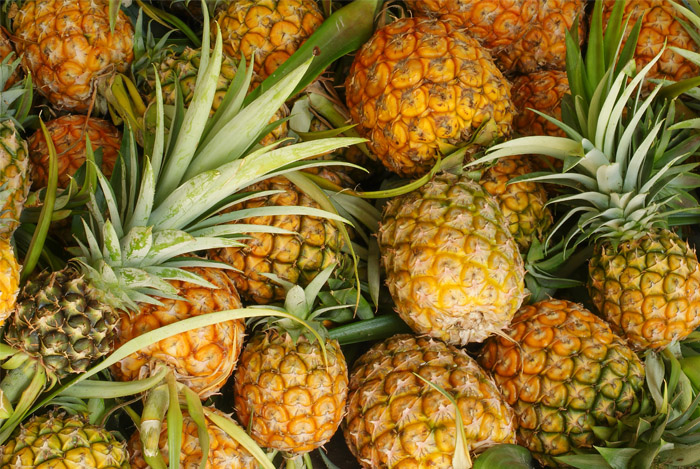 Pineapple is one of the richest sources of the enzyme bromelain, which helps with inflammation and joint pain along with digestive issues, allergies, asthma and sinus infections, says Dr Axe.
Pineapple is one of the richest sources of the enzyme bromelain, which helps with inflammation and joint pain along with digestive issues, allergies, asthma and sinus infections, says Dr Axe.
A study published in July 2014 evaluated bromelain’s ability to treat patients who had impacted third molars extracted.
While this surgery usually causes a lot of pain and swelling, those who were prescribed bromelain reported ‘significantly lower’ post-operation pain, swelling and redness compared to those given a generic pain killer.
If you suffer from joint pain, try some of this tropical fruit, especially the core, which has the most concentrated amounts of bromelain.
Patients suffering from osteoarthritis were given two 650 mg capsules of bromelain two or three times a day, depending on their type of pain.
The pain decreased by up to 60% for acute pain sufferers and more than 50% for those with chronic pain.
However, more research is needed, as there is some uncertainty about how well bromelain from pineapple gets absorbed by the body, given that it may be neutralized by stomach acid.
Soy
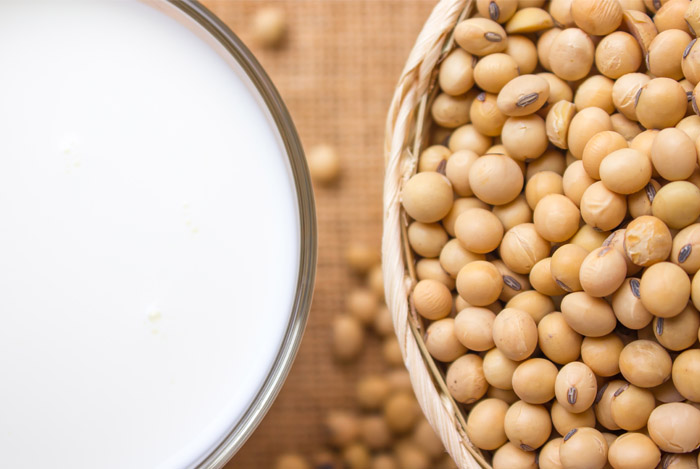 Soy is a hotly debated topic in the health and nutrition world.
Soy is a hotly debated topic in the health and nutrition world.
While many studies have linked soy with cancer, infertility, thyroid problems, hormonal imbalances and mental decline, just as many others have linked it to health benefits.
Plus, soy is a staple in the diet of the Japanese, who boast the most centenarians (people who live to be 100) of anywhere in the world. Their reliance on soy has long been touted as the secret to their long life-spans.
When it comes to pain relief at least, soy may be a superfood.
Researchers from Johns Hopkins found that rats fed a soy-based diet experienced ‘significantly less’ swelling and were able to tolerate more pain than those given a dairy milk protein.
The rats that were fed soy milk were better able to withstand heat that was applied to their paw and had less swelling than rats fed dairy milk.
If you do choose to try soy for pain relief, or simply for its protein content, make sure to choose fermented soy (which also happens to be probiotic rich), which experts believe is the healthiest type of soy.
It’s this fermented soy, such as natto, tempeh and miso, that is eaten in Asia, as opposed to the processed soy so prevalent in the US.
Overall…
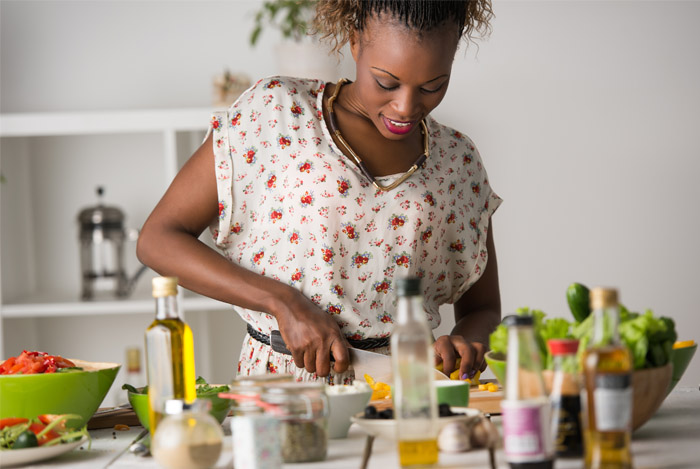 While I’m a great believer in using nutrition to prevent and treat illnesses, there are times when food isn’t enough to deal with chronic or acute pain.
While I’m a great believer in using nutrition to prevent and treat illnesses, there are times when food isn’t enough to deal with chronic or acute pain.
If that’s the case for you, don’t hesitate to get yourself to your doctor.
However, I also think that natural pain relief and medication can be used together to alleviate discomfort and heal the body – but always talk to your doctor first.
Remember, if you follow a healthy eating plan and regular exercise regimen, you might not have to deal with a lot of these aches and pains in the first place.
So over to you – have you ever used food for natural pain relief?
The post 12 Foods to Eat for Natural Pain Relief appeared first on Nutrition Secrets.
http://www.nutritionsecrets.com/natural-pain-relief/
No comments:
Post a Comment